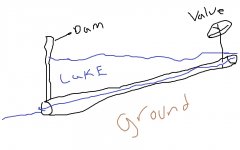Oliver10
Profishional Cupcake
Rusty,
I know a lot of small dams can’t come down because they create lakes and ponds that have fancy houses around them and the political clout is insurmountable. What if there was a way to send the river or stream under the dam and allow for unimpeded flow. There could be valves in the pipe underground that could be constricted to let water back fill the lake or pond when needed. Obviously flood and overflow issues would need to be thought out too. Please excuse my kindergarten drawing below.

I know a lot of small dams can’t come down because they create lakes and ponds that have fancy houses around them and the political clout is insurmountable. What if there was a way to send the river or stream under the dam and allow for unimpeded flow. There could be valves in the pipe underground that could be constricted to let water back fill the lake or pond when needed. Obviously flood and overflow issues would need to be thought out too. Please excuse my kindergarten drawing below.

